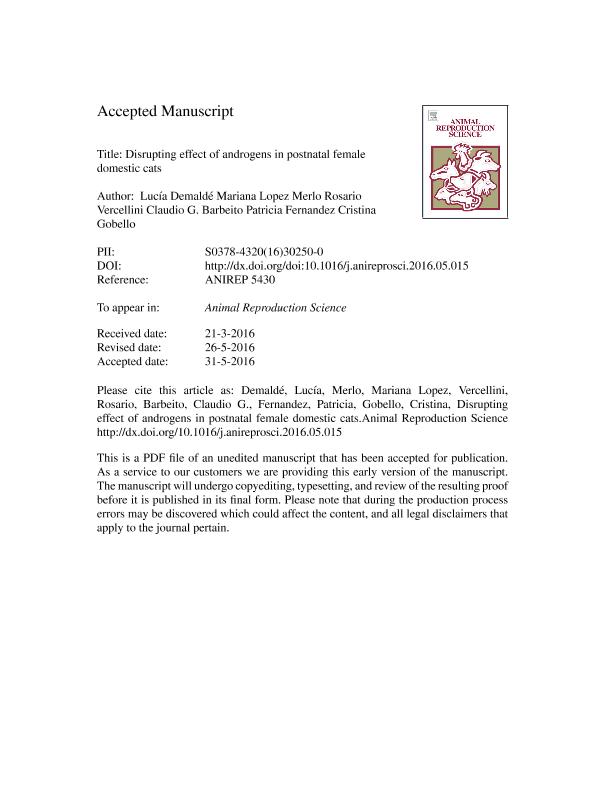Mostrar el registro sencillo del ítem
dc.contributor.author
Demalde, Lucia Ana

dc.contributor.author
López Merlo, Mariana Lucía

dc.contributor.author
Vercellini, Maria del Rosario

dc.contributor.author
Barbeito, Claudio Gustavo

dc.contributor.author
Fernandez, Patricia
dc.contributor.author
Gobello, María Cristina

dc.date.available
2020-09-07T15:12:11Z
dc.date.issued
2016-08
dc.identifier.citation
Demalde, Lucia Ana; López Merlo, Mariana Lucía; Vercellini, Maria del Rosario; Barbeito, Claudio Gustavo; Fernandez, Patricia; et al.; Disrupting effect of androgens in postnatal female domestic cats; Elsevier Science; Animal Reproduction Science; 171; 8-2016; 65-71
dc.identifier.issn
0378-4320
dc.identifier.uri
http://hdl.handle.net/11336/113346
dc.description.abstract
To test the hypothesis that in domestic cats, postnatal androgens induce sterility, the aims of this study were to describe the reproductive effects and the clinical safety of a postnatal administration of a long term release androgen in this species. Thirteen newborn littermate female kittens were randomly assigned to one of the following treatment groups within the first 24 h of birth: testosterone enanthate 12.5 mg sc (TE; n = 8) or Placebo (PL; n = 5). The animals were subsequently assessed for fecal sexual hormones until puberty was attained and subsequently when matings occurred. After 21 days, ovulation and gestation were diagnosed. All queens were subsequently ovario-hysterectomized. Fecal testosterone concentrations differed between the treatment groups throughout the study period (P < 0.05) being greater during the first 2 postnatal weeks in those of the TE group (P < 0.01). Fecal estradiol was not affected by treatment (P > 0.1). While all the females were receptive during the pubertal estrus (P > 0.1), two TE (2/8) compared with all (5/5) females of the PL group had ovulations (P < 0.05). Only one (1/2) compared with three (3/5) of the queens of the TE and PL groups, respectively became pregnant. All kittens of the TE group had transient clitoral enlargement. Anovulatory TE-treated cats had no corpus luteum, and a significant diminution of the endometrial glands as well as of the height of the uterine epithelium. It is concluded that, in domestic cats, a single postnatal supra-physiological dose of testosterone caused a large proportion of queens to be anovulatory and there were also histological endometrial abnormalities that also occurred with this treatment that were accompanied by mild and transient side effects.
dc.format
application/pdf
dc.language.iso
eng
dc.publisher
Elsevier Science

dc.rights
info:eu-repo/semantics/openAccess
dc.rights.uri
https://creativecommons.org/licenses/by-nc-nd/2.5/ar/
dc.subject
ANOVULATION
dc.subject
ENDOCRINE DISRUPTION
dc.subject
FELID
dc.subject
POSTNATAL
dc.subject
TESTOSTERONE
dc.subject.classification
Otras Ciencias Veterinarias

dc.subject.classification
Ciencias Veterinarias

dc.subject.classification
CIENCIAS AGRÍCOLAS

dc.title
Disrupting effect of androgens in postnatal female domestic cats
dc.type
info:eu-repo/semantics/article
dc.type
info:ar-repo/semantics/artículo
dc.type
info:eu-repo/semantics/publishedVersion
dc.date.updated
2020-08-19T20:22:38Z
dc.journal.volume
171
dc.journal.pagination
65-71
dc.journal.pais
Países Bajos

dc.journal.ciudad
Amsterdam
dc.description.fil
Fil: Demalde, Lucia Ana. Consejo Nacional de Investigaciones Científicas y Técnicas. Centro Científico Tecnológico Conicet - La Plata; Argentina. Universidad Nacional de La Plata. Facultad de Ciencias Veterinarias. Departamento de Ciencias Básicas. Laboratorio de Nutrición Mineral y Fisiología Reproductiva; Argentina
dc.description.fil
Fil: López Merlo, Mariana Lucía. Universidad Nacional de La Plata. Facultad de Ciencias Veterinarias. Departamento de Ciencias Básicas. Laboratorio de Nutrición Mineral y Fisiología Reproductiva; Argentina. Consejo Nacional de Investigaciones Científicas y Técnicas. Centro Científico Tecnológico Conicet - La Plata; Argentina
dc.description.fil
Fil: Vercellini, Maria del Rosario. Consejo Nacional de Investigaciones Científicas y Técnicas. Centro Científico Tecnológico Conicet - La Plata; Argentina. Universidad Nacional de La Plata. Facultad de Ciencias Veterinarias. Departamento de Ciencias Básicas. Laboratorio de Nutrición Mineral y Fisiología Reproductiva; Argentina
dc.description.fil
Fil: Barbeito, Claudio Gustavo. Universidad Nacional de La Plata. Facultad de Ciencias Veterinarias. Departamento de Ciencias Básicas. Laboratorio de Nutrición Mineral y Fisiología Reproductiva; Argentina. Consejo Nacional de Investigaciones Científicas y Técnicas. Centro Científico Tecnológico Conicet - La Plata; Argentina
dc.description.fil
Fil: Fernandez, Patricia. Universidad Nacional de La Plata. Facultad de Ciencias Veterinarias. Departamento de Ciencias Básicas. Laboratorio de Nutrición Mineral y Fisiología Reproductiva; Argentina
dc.description.fil
Fil: Gobello, María Cristina. Universidad Nacional de La Plata. Facultad de Ciencias Veterinarias. Departamento de Ciencias Básicas. Laboratorio de Nutrición Mineral y Fisiología Reproductiva; Argentina. Consejo Nacional de Investigaciones Científicas y Técnicas. Centro Científico Tecnológico Conicet - La Plata; Argentina
dc.journal.title
Animal Reproduction Science

dc.relation.alternativeid
info:eu-repo/semantics/altIdentifier/doi/http://dx.doi.org/10.1016/j.anireprosci.2016.05.015
dc.relation.alternativeid
info:eu-repo/semantics/altIdentifier/url/https://www.sciencedirect.com/science/article/abs/pii/S0378432016302500?via%3Dihub
Archivos asociados
